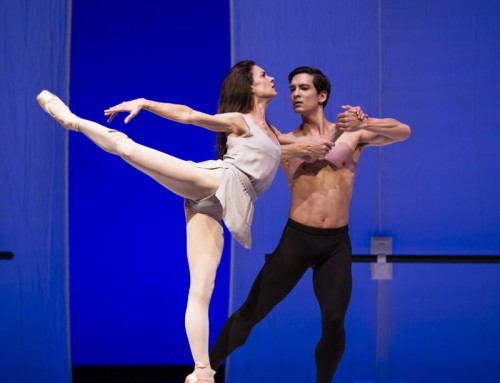Pacific Northwest Ballet:
Opening Night in New York City
Sarah Orza
My husband Seth Orza and I are expecting our first child, a baby girl, in May. So, on Wednesday night, as PNB returned to New York’s City Center for the first time since 1996, I had the opportunity to watch my colleague’s accomplishments–as an audience member. Six months pregnant, I came along on this tour to support my friends, rather than perform with them.
Before moving to Seattle to join PNB with Seth, we lived in New York City for 10 years, dancing for the New York City Ballet. Wednesday evening I ran into quite a few old friends and acquaintances in the City Center audience. I was frequently asked “Is it hard for you to just sit and watch, and not dance?” Quite simply, my answer is no. Perhaps it’s the fact that I am “sidelined” due to something that I am completely over the moon about, rather than an injury. Or that I know I’ll be performing again before I know it. But mostly, I truly relish the opportunity to sit back and take in the sublime artistry my PNB colleagues possess and soak up their honest joy and enthusiasm for our art.
The all Balanchine program opened with Concerto Barocco. This work was originally created on students at the School of American Ballet in 1941. Fittingly, New York City Ballet premiered it at City Center years later, in 1948. To me, this ballet is a study in technique, musicality and pared down elegance. Additionally, it is an endurance marathon; especially for the corps, as they never leave the stage once during the ballet. Needless to say it is best to make sure your ribbons are well secured and your bun is pinned tightly before curtain goes up! PNB’s young corps was precise and musical—they all seemed to feed off the energy that is created when dancing such a special ballet. The two female leads were both premieres. Soloists Laura Gilbreath and Lindsi Dec performed the First and Second violins, respectively. These two beauties both have legs that go on for days. I have never seen such tall woman perform these difficult roles and I had imagined that the fast footwork and quick jumps might be a challenge for their long frames. However, they both had complete control over their bodies and the choreography. Laura’s exquisite line lended itself especially well in the slow adagio of the second movement, while Lindsi managed her own quick jumping sections brilliantly. Bravo to the entire cast!
Second on the program was Balanchine’s iconic Apollo. (Disclaimer; my husband was dancing the title role.) Choreographed on dancers of the Ballets Russes and premiering in 1928, this ballet is in my opinion, one of Balanchine’s finest. Balanchine was noted for saying “Ballet is woman”, so the fact that this ballet is ultimately a gift to the male dancer at its core, is a reflection of the honor it is to dance the role. I know that Seth felt a lot of pressure about debuting the role in New York—the New York City audience knows its stuff and has seen and revered several great Apollos over the years, including PNB’s Artistic Director, Peter Boal. As a dancer, a big challenge when dancing a role is to find a way to make it your own, though you often feel pressure to “fill the shoes” so to speak, of those who have gone before you. Seth felt that his recent debut in Jean-Christophe Maillot’s Roméo et Juliette, and the work he had to do to delve into Romeo’s boyish nature, lended itself well to his Apollo. Apollo’s three muses, Calliope, Polyhymnia, and Terpsichore where danced by Maria Chapman, Lesley Rausch, and Carla Körbes. Carla has been dancing Terpsichore since she was 14. I know that this particular show meant a lot to her, as her entire family was in the audience, all the way from Brazil. Apollo was well received by the audience last night, and the entire cast should be very proud of their work, and the quiet, effortless beauty they all brought to the stage.

Closing the program was Balanchine’s ultimate neo-classical masterpiece, Agon. Another work that showcases the male dancer as well as the female, Agon highlighted some of the wonderful talent currently on PNB’s male roster. Jonathan Porretta has a great mastery of the Balanchine style—his precision and lightning fast movement always surprises and delights me. Andrew Bartee, a young corp member demonstrated considerable skill as well, he seems so well suited for the neo-classical style required for this work. Kylee Kitchens always looks so at home performing Balanchine—I couldn’t take my eyes off her whenever she was onstage.

The ballet culminates with a sensuous pas de deux, which was danced by Lesley Rausch and Batkurhel Bold. Lesley excels in roles such as this. Her facility and demeanor suit the simultaneously angular and lush movement required to execute the choreography well. I thought the pas was absolutely stunning. As company members took their final bows for Agon, my seatmate, an old friend from NYCB, noted that the corp was taking a bow. At City Ballet they do not. I’m so glad my PNB friends could take their well-deserved bow, because from corp member, to soloist to principal dancer, each and every artist on that City Center stage danced from the heart and shared a bit of their soul with us. And this audience member greatly admires, respects, and thanks them for it!
Featured photo: Laura Gilbreath [Tisserand] and Batkhurel Bold in Concerto Barocco. Photo by Angela Sterling.





